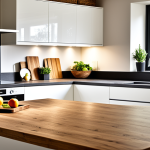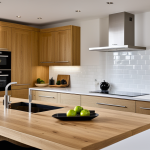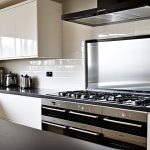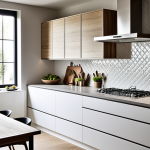Steps to Creating a Sustainable Kitchen
Creating a sustainable kitchen UK begins with a thorough assessment of your current setup. Start by identifying energy-draining appliances, excessive water use, and areas producing unnecessary waste. This step helps to uncover simple yet effective changes aligned with UK sustainability tips.
Next, set clear goals focused on reducing both kitchen waste and energy consumption. For example, aim to minimise single-use plastics, switch to energy-efficient lighting, and optimise recycling habits. Defining measurable targets makes it easier to track progress and maintain motivation throughout the transition.
Also read : What UK kitchen products are recommended for gourmet cooking?
When planning your eco-friendly kitchen design, prioritise practical upgrades like installing water-saving taps, replacing incandescent bulbs with LEDs, or opting for energy-efficient appliances. Consider sustainable materials and products that reduce your kitchen’s overall environmental footprint without sacrificing functionality. Remember, small adjustments add up, and combining changes amplifies long-term impact.
By following these systematic steps—assessment, goal setting, and practical upgrades—you can confidently transition to a sustainable kitchen UK lifestyle that benefits both the environment and your household budget.
In parallel : Discover the best andouillettes for gourmet cuisine
Essential Eco-Friendly Kitchen Products in the UK
Choosing the right eco-friendly kitchen products UK is key to creating a truly sustainable kitchen UK. Start with sustainable kitchenware made from reusable, plastic-free, or recycled materials. Items such as bamboo cutting boards, stainless steel utensils, and glass storage containers reduce waste by replacing single-use plastics.
Energy-efficient appliances play a significant role in reducing your kitchen’s carbon footprint. Opt for fridge-freezers, dishwashers, and cookers with high energy ratings to lower energy consumption and bills. Fixtures like LED bulbs and water-saving taps complement eco-friendly kitchen design by conserving resources without compromising performance.
Natural and biodegradable cleaning products are essential in a sustainable kitchen UK. Avoid harsh chemicals and instead use plant-based detergents and soaps that biodegrade quickly, protecting both your health and the environment.
Incorporating these eco-friendly kitchen products UK not only supports UK sustainability tips but also offers practical benefits in everyday use. Choosing sustainable kitchenware and appliances ensures your kitchen remains efficient and eco-conscious while simplifying maintenance. By focusing on these responsible product choices, you make a tangible impact on resource preservation and waste reduction with every cooking and cleaning task.
Essential Eco-Friendly Kitchen Products in the UK
Choosing the right eco-friendly kitchen products UK is vital in creating a truly sustainable kitchen UK. Sustainable kitchenware typically includes reusable items crafted from natural or recycled materials, such as bamboo cutlery, glass storage jars, and stainless steel containers. These alternatives reduce reliance on single-use plastics, a key point in UK sustainability tips.
Energy-efficient appliances stand out as a cornerstone of an eco-friendly kitchen design. Models rated A+++ consume less power, lowering energy bills and environmental impact simultaneously. Opting for LED lighting and water-efficient taps complements this approach by reducing electricity and water usage.
Natural and biodegradable cleaning products further enhance sustainability. Conventional cleaners often contain harmful chemicals that affect both health and the environment. In contrast, eco-friendly options use plant-based ingredients and biodegradable packaging, reducing toxins and waste.
To summarize, a sustainable kitchen UK thrives on thoughtful choices like reusable kitchenware, energy-saving appliances, and green cleaning products. These choices collectively foster a greener, healthier home environment while aligning with practical UK sustainability tips. Selecting the right combination of eco-friendly kitchen products UK makes sustainable living accessible and impactful.
Leading UK Brands and Where to Buy Eco-Friendly Kitchen Items
Finding trusted UK eco brands is crucial for sourcing quality, sustainable kitchen products. Many eco-friendly kitchen suppliers specialize in items that align with eco-conscious values, offering everything from sustainable kitchenware to energy-efficient gadgets. These brands prioritize transparency in sourcing and production, ensuring materials are responsibly harvested and manufactured.
Shopping from sustainable kitchen stores UK also supports local economies and helps reduce transportation emissions. Many retailers stock green home accessories designed to minimise environmental impact while maintaining style and durability. Examples include reusable beeswax wraps, compostable bin liners, and utensils from reclaimed wood.
Consumers often ask: Where can I find eco-friendly kitchen items in the UK? The answer lies in a mix of dedicated brick-and-mortar shops and reputable online platforms that focus on sustainability. Many stores provide detailed product information, helping you choose items aligned with your eco-friendly kitchen design goals and adhering to popular UK sustainability tips.
Prioritizing UK-based suppliers not only reduces your carbon footprint but encourages innovation in local eco-friendly markets. By purchasing from trusted UK eco brands, you ensure your kitchen upgrades are both environmentally responsible and of high quality.
Steps to Creating a Sustainable Kitchen
Assessing your kitchen for sustainability improvements is the vital first step in creating a sustainable kitchen UK. Begin by scrutinising energy use and waste generation—identify older, inefficient appliances and determine where single-use plastics or food waste accumulate. This targeted evaluation helps prioritise changes aligned with UK sustainability tips, such as reducing unnecessary consumption and improving resource management.
Setting specific goals amplifies success. Define measurable objectives like cutting kitchen waste by a set percentage or lowering electricity consumption through efficient appliances. These clear targets keep efforts focused and progress tangible.
Planning practical changes involves selecting upgrades that balance eco-friendliness with daily convenience. Consider installing LED lighting, water-saving taps, and opting for energy-efficient kitchen appliances rated highly for sustainability. Incorporate eco-friendly kitchen design elements such as reclaimed or natural materials to minimise environmental impact.
By following these aligned steps—assessment, goal setting, and thoughtful upgrades—you lay a strong foundation for a sustainable kitchen UK that supports environmental responsibility while enhancing household efficiency. This structured approach directly addresses both waste and energy use, catering to the key concerns highlighted in UK sustainability tips.
Steps to Creating a Sustainable Kitchen
Assessing your current kitchen is the crucial first step in establishing a sustainable kitchen UK. Begin by scrutinising energy consumption, waste output, and the efficient use of water. Identify appliances that are outdated or draw excessive power, and pinpoint practices that generate avoidable waste or rely on single-use plastics. This targeted assessment sets the stage for impactful changes aligned with UK sustainability tips.
Setting clear, measurable goals directs efforts effectively. For example, aim to reduce kitchen waste by a specific percentage or decrease electricity usage through adopting eco-friendly kitchen design elements like energy-efficient appliances or improved insulation. Defining such targets makes progress tangible and encourages consistent commitment to sustainability.
Planning involves prioritising practical upgrades that balance environmental benefits with functionality. Installing LED lighting, water-saving taps, and selecting appliances with high energy efficiency ratings are key considerations. Incorporate eco-friendly kitchen design materials such as reclaimed wood or recycled composites. These choices reduce your kitchen’s environmental footprint while enhancing usefulness. By following this stepwise approach—assessment, goal setting, and practical changes—you create a sustainable kitchen UK that embraces resource conservation and supports greener living.






